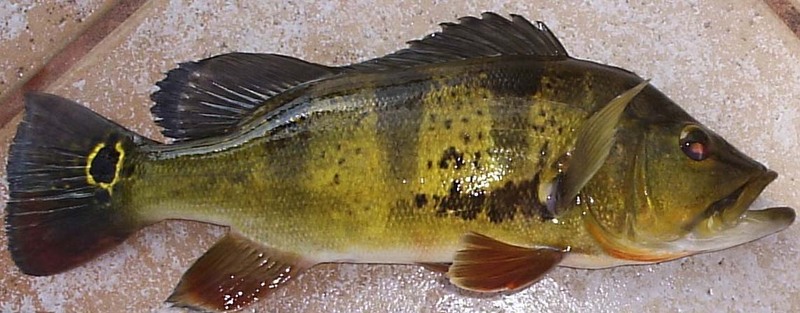| 새로운 사진 | 신문속의 동물소식 | 신기한 동물이야기 | 동물의 소리 | 동물동화상 | 사진 올리기 | 사진 저작권 | English |
|---|
| 재미있는 동물사진 | 괴수/괴어/엽기 동물사진 | 동물이름사전 | 동물목록 | 바깥고리 | 창고입구 | 똑똑누리집 |
|---|
| 이미지 정보 | Original File Name: Butterfly Peacock Bass_01 - Cichla ocellaris.jpg Resolution: 1143x447 File Size: 95561 Bytes Date: 2007:02:16 14:27:59 Upload Time: 2007:10:05 10:05:06 | |
| 올린이 | 이름 (메일주소): Unknown | |
| 사진 제목 | Peacock Bass (Family: Cichlidae, Genus: Cichla) - Wiki | |
 |
| Email : 카드 | 올린이 | 운영자 사진삭제 정보수정 Admin |
| 설명 | Peacock Bass (Family: Cichlidae, Genus: Cichla) - Wiki
Peacock bass
Peacock bass is the common name in English for several species of tropical, freshwater fish of the genus Cichla native to the Amazon River basin of South America. These tropical fish are not true basses, but are rather cichlids. They also exist as non-native species in Colombia, the Dominican Republic, Malaysia, Panama, Puerto Rico, Singapore and parts of the USA (Guam, Florida, Hawaii, and the United States Virgin Islands). Five species There are five known species of peacock bass. The common names for these cichlids vary somewhat depending on the region and, at times, local anglers. The list that follows matches their taxonomic, binomial names (species names) with the common names most widely used in English speaking countries: Cichla temensis (speckled peacock bass but three-barred peacock bass while spawning) Cichla ocellaris (butterfly peacock bass) Cichla intermedia (royal peacock bass) Cichla orinocensis (no English name) Cichla monoculus (no English name) There are many common names for these fish in Brazil (the country of their largest native region) depending on the species and stage of development. The most popular of these is tucunar?? (too-coo-nah-REH). In Spanish, the generic common name for these cichlids is pav??n (pah-VON). Although science knows of only five species, some ichthyologists believe there may be as many as 12 in the freshwater lakes and rivers of South America. The IUCN has never investigated the conservation status of any peacock bass species. Therefore they do not appear on the IUCN red list. Physical traits The speckled peacock bass is the largest of the species and can grow up to 99 centimeters (three feet, four inches) in length. The royal peacock bass is the smallest and grows to a maximum length of 55 centimeters (one foot, 10 inches). Also, most display three vertical stripes on their bodies and a spot on their tail fins that resembles the eyes on a peacock's tail feathers -- a feature which resulted in their English and Spanish common names. In addition, all adult males have a pronounced hump on their foreheads. Other physical traits can vary greatly depending on the species, individual and stage of development. These include but are not limited to: dark rosettes instead of stripes, light speckles, impressive shades of bright green, orange, blue and gold. The stripes, however, tend to fade in late adulthood. Valued as gamefish Sport fishermen have made these cichlids prized game fish for their fighting qualities, so much so that many travel agencies now arrange fishing trips to Brazil and Florida specifically to catch peacock bass. Renowned American peacock bass fisherman and fishing author, Larry Larsen, refers to them as "freshwater bullies" due to their ferocious nature when hunting and their tendency to damage and sometimes destroy fishing gear when striking. Also, the most common techniques for catching them are similar to those for catching largemouth bass with the notable exception that peacock bass will not strike artificial worms -- a widely used lure among largemouth bass fisherman. In addition, fly fishing techniques, including lures such as poppers and large streamers, are becoming increasingly popular for catching these cichlids. Despite their popularity among anglers, some naturalists have identified peacock bass as potential pests for causing ecological imbalances in some of their introduced areas. Eating quality Their eating quality is good. Their flesh is white and sweet when cooked, and has very little oil, making it similar in taste to snapper or grouper. Also, they are not excessively bony. However, most professional American anglers recommend practicing catch and release for these species to protect their numbers in the United States. To help ensure this, Florida Wildlife and Game Commission officers strictly enforce bag limits for these fish. Florida introduction In 1984, Florida officials deliberately introduced butterfly peacock bass and speckled peacock bass to the southern region of that state. There they prey on other non-native and invasive species such as the oscar and the spotted tilapia. Also, their introduction now provides additional sport fishing opportunities for local anglers along with the common snook, largemouth bass and bluegill. While the butterfly peacock bass has flourished there, the speckled peacock bass has not. Therefore, it is now illegal to kill or possess speckled peacock bass in Florida. Because of their tropical origins, peacock bass cannot tolerate low water temperatures. This has prevented them from becoming abundant outside of Miami-Dade and Broward counties within the state of Florida. In the aquarium As aquarium fish they are voracious and predatory, eating any smaller tank mates and fighting with others of equivalent size. They require live food as juveniles but later in their development will accept meaty, dry or frozen foods. Peacock bass tend to grow much larger than most other aquarium fish. To accommodate their size, adults need tanks that hold at least 240 gallons (908.5 liters). However, larger tanks are better. http://en.wikipedia.org/wiki/Peacock_bass
| |||
| 저작권 정보 | 사진의 저작권은 원저작자에게 있습니다. 동물그림창고는 동물관련 사진을 전시할 수 있는 공간만을 제공합니다.사진을 사용하고자 할 경우에는 저작권자와 협의하시기 바랍니다. |
|
|
|
| |||||||
| CopyLeft © since 1995, 동물그림창고. All rights may be reserved. | ||||||||
Stats